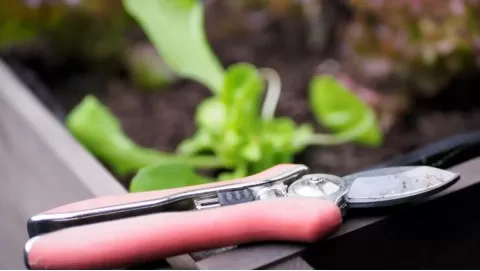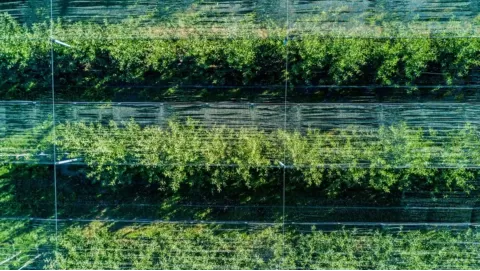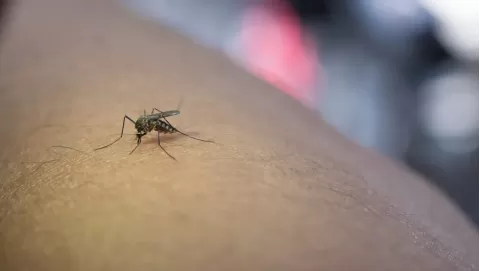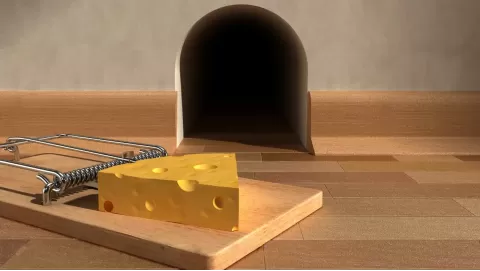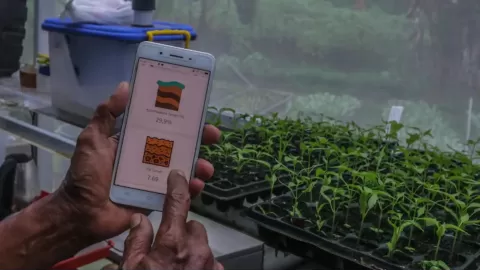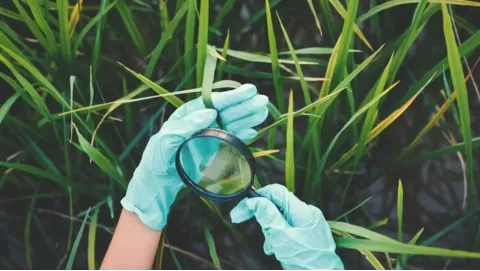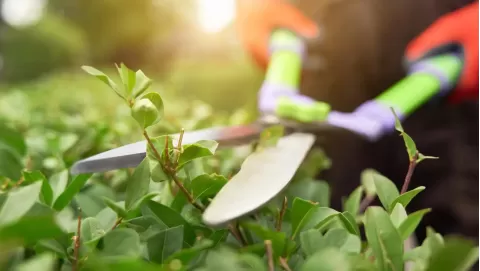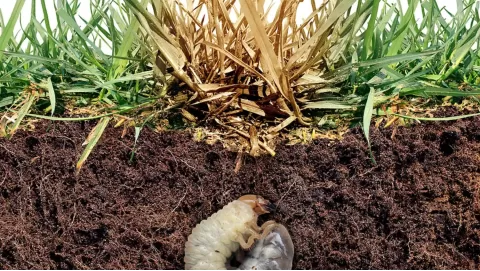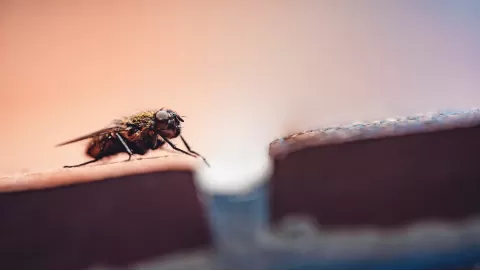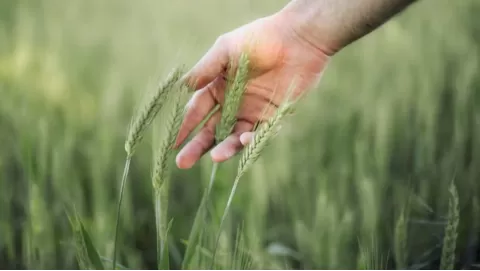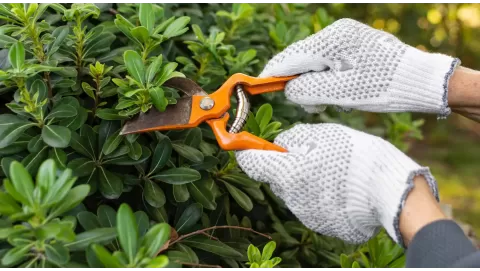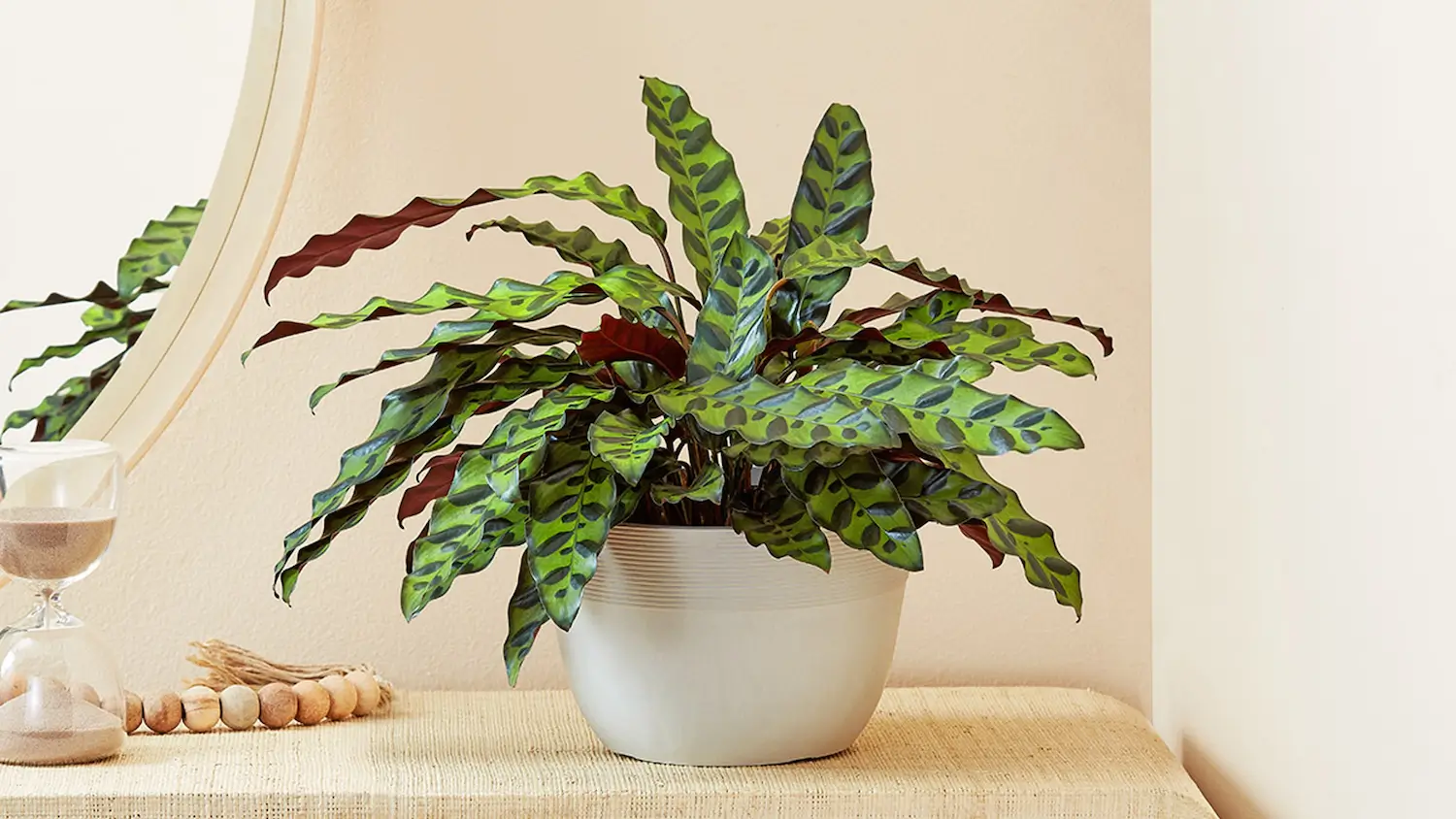
Rattlesnake plant care: Keep your calathea healthy
There is no better way to enhance the indoor aesthetic than to grow houseplants. Maintaining these plants is a helpful, soothing thing that you can do to cope with mental health. One such option is the Rattlesnake plant.
- What: Rattlesnake plant (Calathea lancifolia) is a striking tropical houseplant known for its wavy, patterned leaves and purple undersides.
- Ideal For: Indoor spaces with moderate humidity and indirect light.
- Light: Prefers bright, indirect light but tolerates low-light conditions.
- Watering: Keep soil consistently moist but not soggy; avoid hard or chlorinated water.
- Humidity: Thrives in high humidity; consider misting or using a humidifier.
- Pro Tip: Wipe leaves regularly to remove dust and ensure they can absorb light effectively.
It is easily cultivated, multiplying from the rhizomes in two to three years. And, just like other species of plants that grow inside, it can serve to naturally clean the air. Growcycle has easy instructions on raising these plants. They can also learn about supplements that keep the plants healthy and vibrant.
History and Origin of Rattlesnake Plant
Rattlesnake Plant, also known as Calathea lancifolia, is a tropical plant native to the forests of Brazil. It's in the Marantaceae family, often known as the "prayer plant" family, because the leaves move up and down depending on how much light they're receiving.
Native to warm and humid environments, the Rattlesnake plant does best under the shade of taller trees, in indirect light, and with a steady source of moisture. With its striking foliage, wavy green leaves are lined with deep purple and have a beautiful zebra-style print and a super cool living pattern that resembles a rattlesnake's scales, it's one of the most popular house plants in the world.
The plant is prized since ages for its attractive ornamentation and air-purifying capability. It has also come to represent the exotic allure, class and serenity of the tropics indoors.
Botanical Features
The Rattlesnake plant is known for its striking appearance and unique botanical features:
The Rattlesnake plant is a massive plant in term of its arresting looks and distinctive botanical attributes:
1. Leaves
- Shape and Size: The leaves are long and lanceolate with wavy margins.
- Coloration: The upper side of the leaves displays light and dark green patterns resembling a rattlesnake's skin, while the underside is a rich, deep purple.
- Movement: As with other members of the prayer plant family, the leaves display nyctinasty, closing at night and opening by day in response to light.
2. Growth Habit
- Height: The plant generally stands 2 to 3 feet tall.
- Spread: Growing as a clump, it looks like a bush.
- Propagation: The plant is propagated by rhizomes, which are the horizontal underground stems.
3. Flowers
- Blooming: Rare when grown indoors. The Rattlesnake plant's little, unimportant flowers are white or yellow, and held on short stems in its native.
4. Root System
- Rhizomes: The plant has fat rhizomes that store nutrients and promote new stems.
5. Preferred Conditions
- The plant thrives in warm, moist environments and no direct light, similar to what it would find in a rainforest. It’s happiest in well-drained soil and a touch of moisture.
Benefits of Rattlesnake Plants
The Rattlesnake plant is very beneficial and that is why, these are in high demand for indoor planting:
- Aesthetic Appeal
The attractive green and purple leaves of the Rattlesnake plant make it a beautiful embellishment for your house. The house is more beautiful with these specific patterns and shapes decorating the house. The plant is a tropical plant that can add a sense of life and beauty to any area.
- Air Purification
This plant purifies the indoor air by removing most of the dangerous toxins and exhales fresh oxygen. It helps in cleaning the air and promotes health and comfort.
- Boosts Mental Well-Being
Newsholme says taking care of a Rattlesnake plant may help keep you stress-free and head. It’s gratifying to see it bloom and thrive. And its bright, colorful leaves also make people feel relaxed and happy, potentially boosting the mood.
- Low Maintenance
A good grower, even for the beginner. It performs well indoors, planted in indirect light and watered regularly. It has a tendency to accommodate the shift in habit, so it is a gardener’s favorite.
- Non-Toxic Nature
This is a non-toxic plant safe for homes with pets or small children. Families can gaze at its pretty flourishes without fretting about safety hazards.
- Educational Value
The Rattlesnake plant is one of a kind, as its leaves reposition in light, folding upward at night and spreading in the morning. With such interesting behavior, this may come as a curiosity or a fun plant to watch and learn from.
- Tropical Vibes
Hailing from rainforests, the Rattlesnake plant makes us all the more connected to nature in our indoor living spaces. It brings warmth and life to rooms, creating a connection to the outdoors.
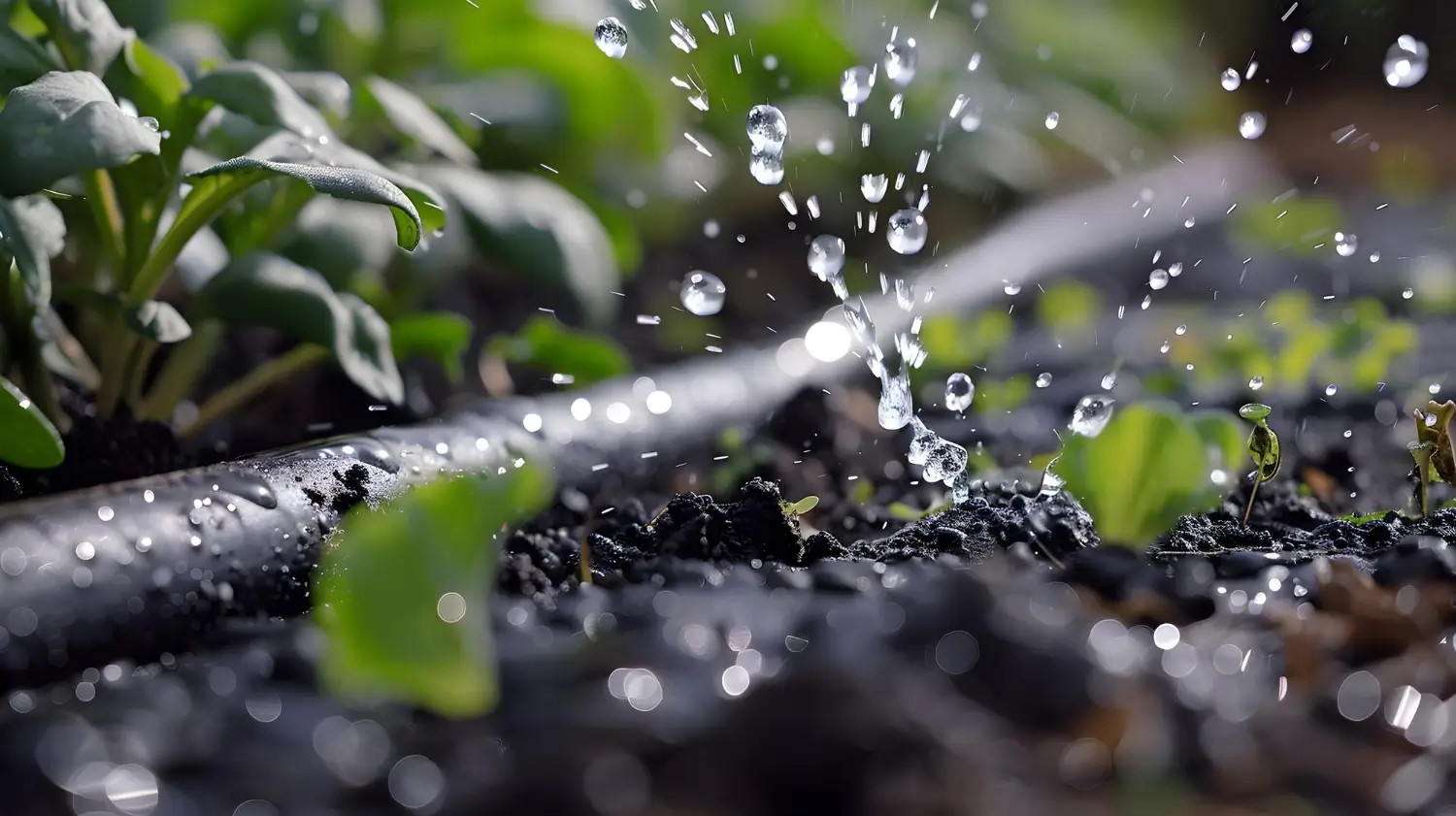
Water Soluble Fertilizers: Fast-Acting Solutions for Healthy Plant Growth
One of the most enjoyable hobbies that a lot of people take pleasure in is gardening since it provides them happiness and calmness when the plants flourish. One important part of helping plants grow strong and healthy is ensuring they get the right nutrients.
LEARN MORE →Tips to Care for Rattlesnake Plant
The Rattlesnake is a striking indoor plant and simple to care for if you know how. The steps outlined below can help the plant grow strong, preserve its vivid patterns, and do well in an indoor environment.
1. Light Requirements
Rattlesnake plant does best in bright, indirect light. It is not too fussy, but avoid direct sun light, which can make its tender foliage turn a little bit crispy or lose its punchy color. If the plant is getting too little light, growth could slow and the leaves might seem dim.
A spot by a window with sheers or filtered sun is best. In rooms with poor lighting, artificial grow lights can be added to ensure that the plant gets enough light without being damaged.
2. Watering
The plant prefers the soil to consistently remain moist, but the plant can’t stand soggy soil. It needs to be watered when the first inch of soil is dry to the touch. Make sure to use lukewarm, filtered, or distilled water to prevent lime scale and hard water chemicals from developing and harming the plant.
Any excess water in the pot can be removed to avoid root rot. With a good routine and keeping track of the soil moisture, the plants are able to keep hydrated without becoming waterlogged.
3. Humidity
Being a tropical plant, the Rattlesnake plant requires high humidity levels, at least 50% and above. The dry air inside, especially in winter, can cause its leaves to dry or curl. It helps to keep the plant in a naturally humid part of the house, for example, the bathroom or kitchen.
Alternatively, a suitable environment can be created by using a humidifier, misting the plant’s leaves with water, or placing it on a tray filled with pebbles and water.
4. Temperature
This plant is best suited to temperatures of 65°F and 80°F (18°C and 27°C). It is also sensitive to rapid temperature changes and should not be placed on cold drafts, air conditioning vents, or heating vents.
Its leaves can be damaged by extreme cold or heat, and their growth stunted. It will grow best if the plant is kept in a warm, stable environment.
5. Soil and Potting
Rattlesnake plant requires well-draining soil that is moist but not waterlogged. For houseplants, a good mix is peat, perlite, and sand.
The plant also grows from rhizomes, and so it’s important to realize that it will provide enough space for those underground stems in your pot. It should be repotted every two years or if the plant grows out of its pot in order for it to spread and grow strong. To prevent water from pooling, always plant in a pot with drainage holes.
6. Fertilizing
A monthly application of fertilizer can be good during the spring and summer growth period. The best fertilizer is a balanced water-soluble fertilizer diluted to half strength. Feeding helps the plant maintain its lush appearance and supports healthy growth.
Over-fertilizing will damage your plant’s roots and will also result in a build-up of salts in the soil. Feed less during the fall and winter months, when the plant growth slows.
7. Pruning
Pruning is not essential for the Rattlesnake plant, but removing yellow, dry, or damaged leaves helps it look tidy and healthy. Trimming dead leaves also prevents unnecessary energy loss and allows the plant to focus on new growth.
Cleaning the leaves regularly with a damp cloth removes dust and helps them absorb more light, keeping their patterns bright and vibrant.
8. Pest Control
The Rattlesnake plant is not susceptible to most pests, though they can on occasion become infested with spider mites, mealy bugs or aphids. Regular checks of leaves for signs of infestation can catch problems early.
Pests can be wiped off the leaves or rinsed with a damp cloth, and insecticidal soap or neem oil work well to get rid of them. Proper humidity also helps to prevent or minimize opportunistic pest problems from becoming troublesome .
9. Propagation
The Rattlesnake plant is easy to propagate by division. Its rhizomes can also be divided when repotting to develop new plants. Each portion should have a good root system and a few leaves before planting in new soil.
Lightly watering the new plants and providing warm, moist conditions helps ensure successful propagation.
Propagating Rattlesnake Plant
Rattlesnake plant is easy to propagate by following the below steps:
1. Get the Required Material
To properly grow a Rattlesnake plant, you'll need to gather a few things first. These include a
- Healthy cutting from a parent plant
- Suitable pots to plant the cutting in healthy and well-draining soil
- Clean water
- Scissors
Sterilize the scissors to prevent contamination during the cutting.
2. Select the Rhizomes to Propagate
Rhizomes are the underground stems from which the roots and shoots of plants grow. They need to reproduce their Rattlesnake plant. Select a healthy and disease-free rhizome (ideally with an eye). The rhizomes chosen should be free from disease so that there would be good, sound propagation for effective plant growth.
3. Divide the Rhizomes
Rattlesnake plant propagation requires rhizome division.To separate the rhizome, remove the plant from the ground so that the rhizomes are visible. When the rhizome is visible, use the sterilized scissors and cut it into portions very carefully. You will want some roots and a piece of stem or leaf in each of your sections. For a better multiplication, take the rhizome in summer or spring.
4. Insert Divisions in Pots
For the pots, use a quality soil mix consisting of two parts of soil that drains well and is nutrient-rich (both peat moss and perlite). Lightly push some soil to the sides of the pot so that you have space in the center. Repeat in each pot, but only put 1 rhizome section in the center of the pot, and do all the pots.
5. Water the Pots
The transplanting of the rhizome, from the soil into a new pot, is going to stress the plant. While you can hope that the rhizome section will recover from this shock, water the soil right after you plant it in the pot to heal the rhizome part. Watering is also ideal for encouraging the growth of the Rattlesnake plant.
But, the application of water should be low and enough only to wet the soil and to enhance the rhizome-soil interaction. Over-applying water at this stage may damage the plant and cause several problems, including root rot.
6. Provide Growing Conditions
Place the pots somewhere with plenty of bright, indirect sunlight. Keep it at a 65 to 80F temperature and a little humidity to help the plant along. Take care to keep potting soil moist at all times, as dry soil can harm the growing Rattlesnake. Seedlings or young plants just established are very susceptible to even slight stress. Make sure the plant is thriving so as not to waste your time.
7. Monitor the Pots
Prevent pots from sowing themselves. After planting, watch the growing crop closely to ensure the environment is conducive. If any stress or disease is detected, take corrective action promptly.
Pruning a Rattlesnake Plant
Pruning the Rattlesnake plant may or may not be all that necessary. However, it may help in giving it a neat, healthy, and vibrant appearance. Pruning on a regular basis will keep the plant looking beautiful and will remove any damaged or unhealthy growth. Here is how to properly prune the Rattlesnake plant:
1. Inspect for Damaged or Yellowing Leaves
Look the plant over for yellow, brown, or damaged leaves. This foliage does very little for the health of the plant and can even make it look scruffy. Also, cut away any leaves that are wilting or that have been infested with pests or diseases.
2. Use Clean, Sharp Tools
Always use clean, sharp scissors or pruners so you do not harm the plant or transfer disease. Clean the tools with rubbing alcohol or a bleach solution to make sure they are not carrying bacteria or fungi. Clean tools are one way to keep the plant healthy and to halt the spread of diseases.
3. Trim Damaged Leaves
To remove a damaged leaf, cut it at its base, located near the soil or main stem. Trim yellowing or brown leaves as such to ensure you don't leave behind any unsightly stubs. Cut gently to avoid damage to healthy leaves growing near the ones you are cutting.
4. Remove Old or Dead Leaves
If any of the remaining, dead leaves have turned brown or dry to the touch, trim them off. Trimming dead leaves will also free up energy and space that would have been otherwise spent on dying leaves, and put it back into the healthy, new growth.
5. Clean the Plant’s Leaves
Wiping the leaves with a damp cloth on a regular basis will help keep them clean and free from dust. It also allows the plant to take in more light, which it needs to grow. Clean leaves also look better and healthier.
6. Avoid Over-Pruning
It’s good to remove bad or dead leaves, but don’t cut healthy leaves if it’s not necessary. Over-pruning may stress the plant and can inhibit its growth. Practice restraint and prune only when necessary, and always by enhancing the overall appearance without overdoing it.
7. Dispose of Pruned Material
Remove all cut leaves or debris after pruning. If the grower sees any evidence of pests or disease on the material they have removed, they should get it far away from the plant to prevent it from infecting the plant.
Common Problems and Solutions of Rattlesnake Plant
Though the plant has naturally antimicrobial and anti-pest characteristic properties, it is observed that a few diseases and pest attacks the plant. Here are a few other issues with Rattlesnake plants and how to fix them:
- Reduced Growth
Potted rattlesnake plants may experience slow growth or even no growth for a few reasons. The most common factors are low light or light watering, and poor air movement around the plant can also stunt growth.
Loosen the potting soil to improve its airflow. Trim the excess root to have new root growth. Move the pot location so that both sides receive the necessary light and grow evenly.
- Leaf Discoloration
Rattlesnake leaves may yellow or turn brown when exposed to direct sunlight. The young blades or seedlings are relatively weak and do not tolerate the strong sunlight and become yellow or even die.
Immediately take the plant to the indirect light or install an appropriate curtain for protection. Trim the burnt leaves and give it a mild feeding to help the plant recover from the shock.
- Root Rot
Root rot is a fungal disease, and there are a few reasons why Rattlesnake plants may get it. Excess water retention in the potting soil is the root cause of root rot. The poor drainage also leads to water stagnation in the roots and fungal attacks.
Plants should have plenty of drainage holes. Low-intensity water splashes can keep the soil moist. Keep an eye on the water needs of the soil without adding too much water.
FAQs
Why does my Rattlesnake plant stand up at night?
The Rattlesnake plant’s leaves close up or stand erect at night in a process known as “nyctinasty,” a phenomenon found in certain types of flora which is thought to help plants save energy and lessen water loss.
Where should I put my Rattlesnake plant?
Position your Rattlesnake plant in bright, indirect light, out of reach of direct sunlight. It also prefers moderate light and high humidity, such as in a bathroom or kitchen.
Is the Rattlesnake plant poisonous?
No, the Rattlesnake plant is safe for humans and pets alike.
The Bottom Line
Rattlesnake plants offer those in search of good looks with small square footage in which to grow. These are slow-growing and easily propagated from parent plant’s rhizomes, making them great for beginner and seasoned gardeners alike. They thrive with very little attention.
However, the plant must be monitored and provided with the right conditions to ensure the best growth. Growcycle offers helpful solutions for keeping indoor plants healthy and thriving.
Disclaimer: This material is for informational purposes only and should not be relied on for legal, medical, financial, or any other form of professional advice.







